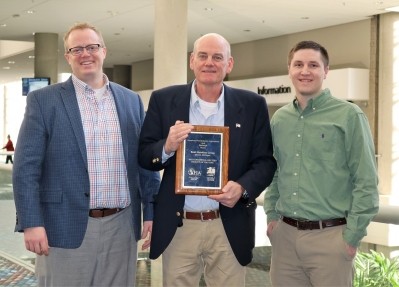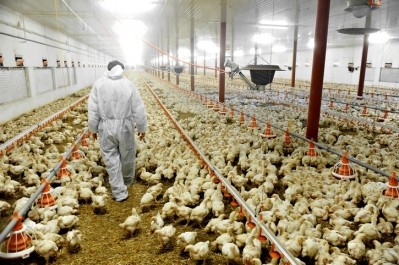Special Edition: Reports from IPPE
New Kent feed facility starts to take shape

We caught up with Mike Gauss, vice president of operations at Kent Nutrition Group, at the International Processing and Packaging Expo (IPPE) in Atlanta to hear more about the work the company is doing with a new feed mill in Sheldon, Iowa.
We also heard how Kent has been using new feed production technology to address quality.
The company announced that it was starting work on a new feed mill in September 2017. When complete it will produce feed for pigs, dairy and beef cows.
The first goal for the plant was to finish some site work and structural foundations before winter, said Gauss. The foundation work was completed and building efforts are continuing.
“We’re trying to design and build the plant in 18 months, which is an aggressive goal for a plant this size,” he added.
Overall, the project appears to be in a good position at this point, he said.
“Most of the major equipment has been specified and ordered,” he said. “All process design is pretty well complete and so we’re coming along quite well. I’m pleased with where we’re at – we’ve still a long way to go.”
However, the new feed mill is not the only project the company is undertaking, said Gauss.
“We’re doing a lot of things currently that, yes, they might gain some efficiency, so you might gain some financial reward, but the main driver for many of them is the quality aspect,” he said.
“Across all of the plants right now we’re updating our batching control systems where we’re implementing a number of quality enhancements to ensure that we get the right ingredients in every feed.”
Technology innovations
The new batching system interacts with feed formulation software and can automatically pull in formulations and control ingredient inclusion, said Gauss.
“What’s really driving the innovation there is we’re doing a lot around of lot code tracking around barcode scanning – every ingredient as it comes in the door it has a barcode assigned to it,” he said.
“Whenever that is used, through the plant those barcodes are scanned and then that is tracking against the database within the batching system to ensure that the right ingredient is going into the right tin to be put into the right product… We’re helping from keeping honest people from making honest mistakes.”
The new system also has improved product traceability and helps address Food Safety Modernization Act requirements (FSMA), he said.
“We don’t ever want to have an issue but if we were ever in a situation where we did have to have some kind of market retrieval we have the ability to pull those records very quickly,” he added.
The new system also offers the ability to track how operators are working with the system, any alarms or overrides that take place and to follow weight tolerances for products, he said.
“You can run ingredient inventories which is very beneficial,” said Gauss. “And it will track exact usage instead of theoretical usages which is very nice for inventory management.”
There have been changes that improve efficiency and speed regarding product mixing, pelleting and packaging, he said. Ongoing automation efforts also are providing quality returns and an additional safeguard for products and employees.
“Another thing that we have done is actually gone through and automated all of our standard operating procedures from scheduling to sequencing and flushing to once again help honest people not make honest mistakes,” he said.
“We’ve taken all of our SOPs and in essence digitized them and plugged them into the operating systems so someone is not allowed to schedule feed improperly – they cannot choose to schedule one type of feed after another that they shouldn’t be, so it gives a very nice double check to ensure that we are taking every opportunity to ensure the quality of our products.”
The additional automation also means that there some safety parameters for employees can be improved as less manual labor is needed, he said.
“In addition to that, we’re doing a number of projects that really center around flexibility for our customers,” said Gauss. “The usage of unique ingredients continues to expand, and as much as, from an operations standpoint, I’d like to use fewer ingredients, that’s not what the nutritionist or our customers are demanding.”
“Having flexibility around those ingredients, having capability to handle ingredients in multiple forms and in multiples types of packaging is critical for us,” he said. “We’ve been doing multiple projects to address some of those topics as well.”
Remaining industry challenges
However, there is still work to be done looking at the use of technology in feed production, said Gauss. Any advancement that could be made to the flushing and carryover process would be supported.
“From a quality and an FSMA standpoint, anything that equipment companies can do to reduce carryover, residue those type of things is very beneficial for us,” he said. “We do sequencing and flushing studies and then set the size of our flushing to ensure that we have no residual carryover – if we could reduce those that [would be] really beneficial.”
There has been improvement made in that area, but more room remains, he said. “Truly it’s the cleanout is the number one thing that equipment companies could work on,” he added.

















